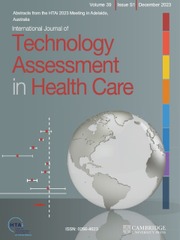Crossref Citations
This article has been cited by the following publications. This list is generated based on data provided by
Crossref.
Hailey, David
1994.
Health care technology in Australia.
Health Policy,
Vol. 30,
Issue. 1-3,
p.
23.
Hailey, David M.
1996.
Developments and outcomes in Australian diagnostic imaging services.
Academic Radiology,
Vol. 3,
Issue. ,
p.
S92.
Hailey, David
1997.
Australian economic evaluation and government decisions on pharmaceuticals, compared to assessment of other health technologies.
Social Science & Medicine,
Vol. 45,
Issue. 4,
p.
563.
Jacob, Robert
and
Mcgregor, Maurice
1997.
Assessing the Impact of Health Technology Assessment.
International Journal of Technology Assessment in Health Care,
Vol. 13,
Issue. 1,
p.
68.
Lehoux, Pascale
Denis, Jean-Louis
Tailliez, Stéphanie
and
Hivon, Myriam
2005.
Dissemination of Health Technology Assessments: Identifying the Visions Guiding an Evolving Policy Innovation in Canada.
Journal of Health Politics, Policy and Law,
Vol. 30,
Issue. 4,
p.
603.
Hailey, David
2009.
The history of health technology assessment in Australia.
International Journal of Technology Assessment in Health Care,
Vol. 25,
Issue. S1,
p.
61.
Widrig, Daniel
2015.
Health Technology Assessment.
Vol. 44,
Issue. ,
p.
41.
Merlo, Gregory
Page, Katie
Zardo, Pauline
and
Graves, Nicholas
2019.
Applying an Implementation Framework to the Use of Evidence from Economic Evaluations in Making Healthcare Decisions.
Applied Health Economics and Health Policy,
Vol. 17,
Issue. 4,
p.
533.




